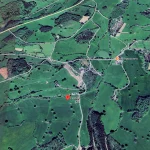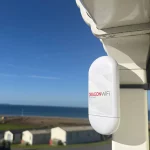2022 H1 – UK Coverage of Gigabit Broadband Nears 70 Percent

The latest independent biannual summary of UK broadband coverage for H1 2022 has estimated that “full fibre” (FTTP) ISP networks have boosted their reach to 37.61% of premises (up from 30.23% in H2 2021) and 69.24% are within reach of “gigabit” speeds (up from 65.22%). But the results vary around England, Wales, Scotland and N.Ireland.
The focus, both politically and generally, is currently on enhancing “gigabit” (1000Mbps+ or 1Gbps+) class networks. At present virtually all of this new gigabit connectivity is coming from Fibre-to-the-Premises (FTTP) based networks via Openreach (BT), Hyperoptic, CityFibre, CommunityFibre, G.Network, Gigaclear and many others (Summary of Full Fibre Builds).
However, Virgin Media’s (VMO2) recent upgrade to DOCSIS 3.1 technology – spread across both their new FTTP and existing Hybrid Fibre Coax (HFC) networks (here) – did change this dynamic. The aforementioned upgrade completed at the end of last year and now covers nearly 16 million premises, which explains why gigabit coverage has improved so rapidly since 2019. But progress will now be slower because a lot of urban focused FTTP builds will be overbuilding HFC.
Advertisement
At present, most of the progress on gigabit-capable network coverage is still thanks to commercial investment, often with a little support from the Government’s various voucher schemes. But we also expect the new £5bn Project Gigabit (F20) programme to start having a tiny impact from the end of this year (unless delays creep in), before rising faster through 2023 and onwards.
Meanwhile, those still stuck in sub-10Mbps areas will, for the time being, be left with little option but to either try harnessing the Government’s flawed 10Mbps Universal Service Obligation (USO), opt for a satellite solution (Starlink is good, if you can afford it) or wait for a fixed line upgrade. People taking the USO are being promised speeds of over 10Mbps (often via 4G rather than fibre), but some of those are already finding that they live in areas where not even the USO can cover the colossal upgrade costs (here and here). The government are still examining support options for such remote premises.
Listed below is the latest modelling from Thinkbroadband to July 2022 (H1 – 2022). We should point out that the figure for ‘Under 10Mbps‘ doesn’t reflect 4G mobile coverage, which plays a part in the official USO but isn’t included in TBB’s mapping work; it’s incredibly difficult to do an accurate model for mobile coverage.
Fixed Broadband Network Availability H1 – 2022
Advertisement
| Area | 30Mbps+ | Full Fibre | Gigabit | % Under 10Mbps |
| England | 97.6% (97.39%) | 36.50% (29.13%) | 70.28% (66.56%) | 0.7% (0.82%) |
| UK | 97.2% (96.89%) | 37.61% (30.23%) | 69.24% (65.27%) |
1.1% (1.21%) |
| Wales | 96.3% (95.86%) | 35.16% (27.69%) | 52.4% (46.40%) | 1.9% (2.16%) |
| Scotland | 95% (94.76%) | 34.42% (27.77%) | 63.42% (59.39%) | 2.8% (2.92%) |
| N.Ireland | 92.6% (90.82%) | 84.88% (75.58%) | 85.98% (78.83%) | 4.9% (5.90%) |
NOTE 1: Nearly all of the gigabit coverage is coming from Virgin Media’s existing HFC cable network, although Openreach, Hyperoptic, Gigaclear, Cityfibre and others all have big “full fibre” (FTTP) expansion plans. But there’s a lot of overbuild between HFC and FTTP, so future progress post-2021 will be slower now that VM has completed their upgrade.
NOTE 2: It’s very important to remember that Government / political coverage targets, like 85% for gigabit-capable, reflect a national average, which can of course be better or worse for some areas (e.g. a few may achieve higher coverage, while others could be well below that).
Take note that each devolved region (Scotland, Wales etc.) has its own policy and targets, which all feed into the central UK figure. For example, while Northern Ireland may be behind on superfast speeds and good coverage for the USO, their full fibre coverage is MILES ahead of other regions, and we suspect they’ll also be one of the first to achieve near universal coverage of gigabit-capable broadband.
As stated earlier, this data is an estimate and should be taken with a pinch of salt, not least because it won’t always reflect the very latest real-world position. But it’s still one of the best and most up-to-date gauges that we have for checking against official claims (official figures tend to be a tiny bit higher than TBB’s due to differences in data modelling etc.).
Mark is a professional technology writer, IT consultant and computer engineer from Dorset (England), he also founded ISPreview in 1999 and enjoys analysing the latest telecoms and broadband developments. Find me on X (Twitter), Mastodon, Facebook, BlueSky, Threads.net and Linkedin.
« Court Orders UK ISP Jurassic Fibre to Pay £13k in Street Works Fines






















































That is actually very impressive
Makes reading these kind of articles hard when you are still in the percentage that can’t.
I second this especially when 200 of the most rural properties around my town already have FTTP via Openreach yet the majority of us in the town cannot get it.
What are the options available in each country, while 30mbps is available to most, can they actually buy that technology eg fttc, openreach have a stop sell in place for copper based products in almost half of all exchanges
Take it you don’t understand the stop sell process? If a premise doesn’t have availability of FTTP they can still get FTTC/ADSL in a stop sell exchange
As all the data is an estimate what do they estimate the percentage error is for them?
Does thinkbroadband say it is an estimate?
7.4% of the UK passed with full fibre in 6 months and it’s still accelerating.
Late to the party but building very quickly now. 75% by 2025 seems quite realistic.
This is a bit misleading. It doesn’t take the upload speed into account. And the full fibre coverage only is about 1/3 of the country.
Off-hand, I don’t know of many network availability (not to be confused with speed testing) studies that give % figures for coverage by upload speed. But you can interpret some of that from the results above. For example, we could say that the gigabit-coverage figure also reflects an upload speed of – at the very at least – 50Mbps+ (Virgin). Similarly, full fibre networks usually offer uploads of at least 100Mbps.
As for full fibre coverage, going from 30.23% to 37.61% in the space of around 6 months is huge. We’ve long been behind most other countries in Europe, but we’re now catching up fast.
Fair enough. However, as far as I remember the maximum Openreach fibre upload speed of 115Mbps is only available for their top-level 900Mbps package. And a FTTPoD package doesn’t even exceed 50Mbps upload speed. Only altnets appear to have more useful symmetric fibre offers at the moment.
Isn’t the low upload with Openreach more down to them wanting to protect their leased line products than actual practicality?
Openreach have added another category (PINK/April’22-April’26) to the key on their full fibre build map but don’t appear to have applied it to any region yet.
https://www.openreach.com/fibre-broadband/where-when-building-ultrafast-full-fibre-broadband
All the light red/brown areas are the pre-existing April 2021 to December 2026 category.
That’s to reflect the additional locations they added about a month ago (e.g. Durham), all of those seem to fit within the new window.
I suspect most of those Brown areas will have altnets by the time OR bothers to show up.
I thought I read even though it’s brown they only do upto 75% in first stage and return years later? Being on Exchange only lines it will be years way past 2026 til we get anything.
I’m just happy i have fttp and don’t need anything else. I hope companies like BT will be gone these clowns are bad.
While it can be a problem that Openreach is owned by BT, the recent rollout of fibre by them has been good, and many ISPs using Openreach fibre offer better customer services and support than BT Broadband. The main issue with Openreach-based fibre is the lack of symmetric fibre (e.g. upload speed the same as download), this is where altnets have a clear advantage, but their market share and coverage is smaller.
If Openreach didn’t have a guaranteed major customer (BT Broadband, EE Broadband and Plusnet) then I doubt they could have invested so much money and built so quickly, it would have been too much risk. So you may not like BT owning Openreach, but we do benefit from it and that may be why Ofcom have tolerated it for so long.
Not surprised the figures are jumping based on local evidence to me. In Jan we had no options but ~30 FTTC but already have two providers (Trooli and Giganet) laying FTTP at speed. Been told I can take a service by Giganet in approximately September. With a turnaround from nothing to 2 providers in 9 months it shows the speed of altnets at least. I will note that BT FTTP is no where to been seen in my town outside of a few high street businesses and VM while doing odd work in the area have nothing planned either.
Firstly, from my personal experience, these statistics are total bullshit. The area in the centre of my town is reported “gigabit” when they can only get ADSL2+. What a load of shit. Secondly, “Gigabit” is only statistically viable if there is at LEAST 2 independent netwotks available. The trash of VM alone does not constitute a “gigabit network” lol.
Only adsl2+ if so name town so things can get checked.
Or as sounds you dismiss virgin media so data is correct but does not suit your beliefs